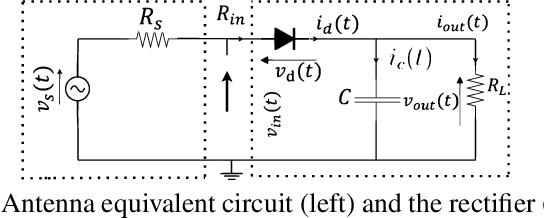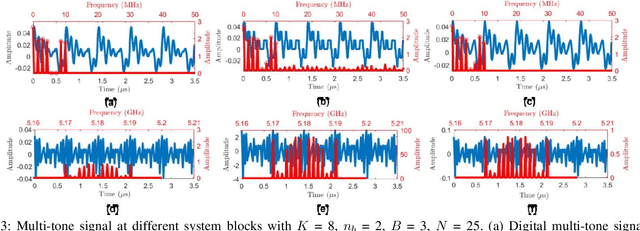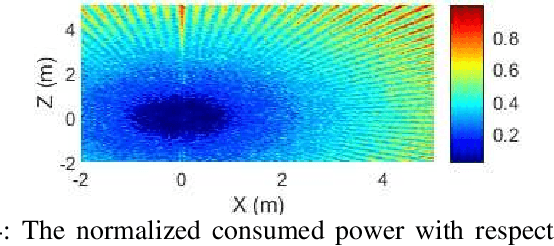Amirhossein Azarbahram
Centre for Wireless Communications
Sense-then-Charge: Wireless Power Transfer to Unresponsive Devices with Unknown Location
Apr 29, 2025Abstract:This paper explores a multi-antenna dual-functional radio frequency (RF) wireless power transfer (WPT) and radar system to charge multiple unresponsive devices. We formulate a beamforming problem to maximize the minimum received power at the devices without prior location and channel state information (CSI) knowledge. We propose dividing transmission blocks into sensing and charging phases. First, the location of the devices is estimated by sending sensing signals and performing multiple signal classification and least square estimation on the received echo. Then, the estimations are used for CSI prediction and RF-WPT beamforming. Simulation results reveal that there is an optimal number of blocks allocated for sensing and charging depending on the system setup. Our sense-then-charge (STC) protocol can outperform CSI-free benchmarks and achieve near-optimal performance with a sufficient number of receive antennas and transmit power. However, STC struggles if using insufficient antennas or power as device numbers grow.
Beamforming and Waveform Optimization for RF Wireless Power Transfer with Beyond Diagonal Reconfigurable Intelligent Surfaces
Feb 26, 2025Abstract:Radio frequency (RF) wireless power transfer (WPT) is a promising technology to seamlessly charge low-power devices, but its low end-to-end power transfer efficiency remains a critical challenge. To address the latter, low-cost transmit/radiating architectures, e.g., based on reconfigurable intelligent surfaces (RISs), have shown great potential. Beyond diagonal (BD) RIS is a novel branch of RIS offering enhanced performance over traditional diagonal RIS (D-RIS) in wireless communications, but its potential gains in RF-WPT remain unexplored. Motivated by this, we analyze a BD-RIS-assisted single-antenna RF-WPT system to charge a single rectifier, and formulate a joint beamforming and multi-carrier waveform optimization problem aiming to maximize the harvested power. We propose two solutions relying on semi-definite programming for fully connected BD-RIS and an efficient low-complexity iterative method relying on successive convex approximation. Numerical results show that the proposed algorithms converge to a local optimum and that adding transmit sub-carriers or RIS elements improves the harvesting performance. We show that the transmit power budget impacts the relative power allocation among different sub-carriers depending on the rectifier's operating regime, while BD-RIS shapes the cascade channel differently for frequency-selective and flat scenarios. Finally, we verify by simulation that BD-RIS and D-RIS achieve the same performance under pure far-field line-of-sight conditions (in the absence of mutual coupling). Meanwhile, BD-RIS outperforms D-RIS as the non-line-of-sight components of the channel become dominant.
End-to-End Waveform and Beamforming Optimization for RF Wireless Power Transfer
May 09, 2024



Abstract:Radio frequency (RF) wireless power transfer (WPT) is a key technology for future low-power wireless systems. However, the inherently low end-to-end power transfer efficiency (PTE) is challenging for practical applications. The main factors contributing to it are the channel losses, transceivers' power consumption, and losses related, e.g., to the digital-to-analog converter (DAC), high-power amplifier, and rectenna. Optimizing PTE requires careful consideration of these factors, motivating the current work. Herein, we consider an analog multi-antenna power transmitter that aims to charge a single energy harvester. We first provide a mathematical framework to calculate the harvested power from multi-tone signal transmissions and the system power consumption. Then, we formulate the joint waveform and analog beamforming design problem to minimize power consumption and meet the charging requirements. Finally, we propose an optimization approach relying on swarm intelligence to solve the specified problem. Simulation results quantify the power consumption reduction as the DAC, phase shifters resolution, and antenna length are increased, while it is seen that increasing system frequency results in higher power consumption.
Zero-energy Devices for 6G: Technical Enablers at a Glance
Feb 14, 2024Abstract:Low-cost, resource-constrained, maintenance-free, and energy-harvesting (EH) Internet of Things (IoT) devices, referred to as zero-energy devices (ZEDs), are rapidly attracting attention from industry and academia due to their myriad of applications. To date, such devices remain primarily unsupported by modern IoT connectivity solutions due to their intrinsic fabrication, hardware, deployment, and operation limitations, while lacking clarity on their key technical enablers and prospects. Herein, we address this by discussing the main characteristics and enabling technologies of ZEDs within the next generation of mobile networks, specifically focusing on unconventional EH sources, multi-source EH, power management, energy storage solutions, manufacturing material and practices, backscattering, and low-complexity receivers. Moreover, we highlight the need for lightweight and energy-aware computing, communication, and scheduling protocols, while discussing potential approaches related to TinyML, duty cycling, and infrastructure enablers like radio frequency wireless power transfer and wake-up protocols. Challenging aspects and open research directions are identified and discussed in all the cases. Finally, we showcase an experimental ZED proof-of-concept related to ambient cellular backscattering.
On the Radio Stripe Deployment for Indoor RF Wireless Power Transfer
Oct 14, 2023Abstract:One of the primary goals of future wireless systems is to foster sustainability, for which, radio frequency (RF) wireless power transfer (WPT) is considered a key technology enabler. The key challenge of RF-WPT systems is the extremely low end-to-end efficiency, mainly due to the losses introduced by the wireless channel. Distributed antenna systems are undoubtedly appealing as they can significantly shorten the charging distances, thus, reducing channel losses. Interestingly, radio stripe systems provide a cost-efficient and scalable way to deploy a distributed multi-antenna system, and thus have received a lot of attention recently. Herein, we consider an RF-WPT system with a transmit radio stripe network to charge multiple indoor energy hotspots, i.e., spatial regions where the energy harvesting devices are expected to be located, including near-field locations. We formulate the optimal radio stripe deployment problem aimed to maximize the minimum power received by the users and explore two specific predefined shapes, namely the straight line and polygon-shaped configurations. Then, we provide efficient solutions relying on geometric programming to optimize the location of the radio stripe elements. The results demonstrate that the proposed radio stripe deployments outperform a central fully-digital square array with the same number of elements and utilizing larger radio stripe lengths can enhance the performance, while increasing the system frequency may degrade it.
Energy Beamforming for RF Wireless Power Transfer with Dynamic Metasurface Antennas
Jul 03, 2023Abstract:Radio frequency (RF) wireless power transfer (WPT) is a promising technology for Internet of Things networks. However, RF-WPT is still energy inefficient, calling for advances in waveform optimization, distributed antenna, and energy beamforming (EB). In particular, EB can compensate for the severe propagation loss by directing beams toward the devices. The EB flexibility depends on the transmitter architecture, existing a trade-off between cost/complexity and degrees of freedom. Thus, simpler architectures such as dynamic metasurface antennas (DMAs) are gaining attention. Herein, we consider an RF-WPT system with a transmit DMA for meeting the EH requirements of multiple devices and formulate an optimization problem for the minimum-power design. First, we provide a mathematical model to capture the frequency-dependant signal propagation effect in the DMA architecture. Next, we propose a solution based on semi-definite programming and alternating optimization. Results show that a DMA-based implementation can outperform a fully-digital structure and that utilizing a larger antenna array can reduce the required transmit power, while the operation frequency does not influence much the performance.
Waveform and Beamforming Optimization for Wireless Power Transfer with Dynamic Metasurface Antennas
Jul 03, 2023Abstract:Radio frequency (RF) wireless power transfer (WPT) is a promising charging technology for future wireless systems. However, low end-to-end power transfer efficiency (PTE) is a critical challenge for practical implementations. One of the main inefficiency sources is the power consumption and loss of key components such as the high-power amplifier (HPA) and rectenna, which must be considered for PTE optimization. Herein, we investigate the power consumption of an RF-WPT system considering the emerging dynamic metasurface antenna (DMA) as the transmitter. Moreover, we incorporate the HPA and rectenna non-linearities and consider the Doherty HPA to reduce power consumption. We provide a mathematical framework to calculate each user's harvested power from multi-tone signal transmissions and the system power consumption. Then, the waveform and beamforming are designed using swarm-based intelligence to minimize power consumption while satisfying the users' energy harvesting (EH) requirements. Numerical results manifest that increasing the number of transmit tones enhances the performance in terms of coverage probability and power consumption since the HPAs operate below the saturation region in the simulation setup and the EH non-linearity is the dominant factor. Finally, our findings demonstrate that a properly shaped DMA may outperform a fully-digital antenna of the same size.
 Add to Chrome
Add to Chrome Add to Firefox
Add to Firefox Add to Edge
Add to Edge